
(a)
Interpretation:
Synthesis of
Concept introduction:
Synthesis is the process of conversion of one compound into another using reagents. For the conversion of one compound into another, multiple number of steps undergoes using multiple reagents.
Answer to Problem 20.47AP
Synthesis of

Explanation of Solution
The synthesis of

Figure 1
The total number of steps in the synthesis are five. In the first step propanoic acid is converted into acid chloride which is converted into
The ketone
Synthesis of
(b)
Interpretation:
Synthesis of the given compound from allyl alcohol using appropriate reagents is to be stated.
Concept introduction:
Synthesis is the process of conversion of one compound into another using reagents. For the conversion of one compound into another, the multiple numbers of steps undergo using multiple reagents.
Answer to Problem 20.47AP
Synthesis of the given compound from allyl alcohol using appropriate reagents is shown below.
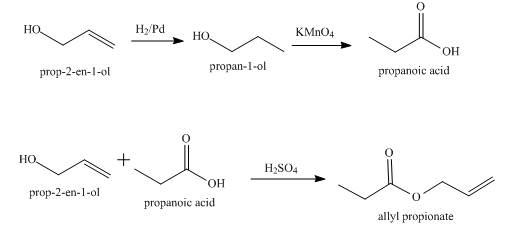
Explanation of Solution
The given compound to be synthesized is shown below.

Figure 2
The synthesis of the given compound from allyl alcohol is done using multiple steps shown below.

Figure 3
The allyl alcohol,
Synthesis of the given compound from allyl alcohol using appropriate reagents is shown in Figure 3.
(c)
Interpretation:
Synthesis of
Concept introduction:
Synthesis is the process of conversion of one compound into another using reagents. For the conversion of one compound into another, the multiple numbers of steps undergo using multiple reagents.
Answer to Problem 20.47AP
Synthesis of
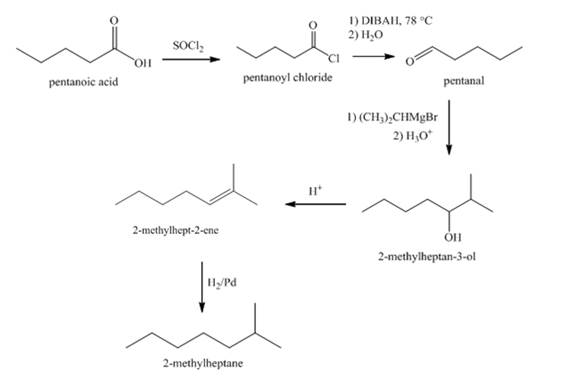
Explanation of Solution
The synthesis of

Figure 4
The conversion of pentanoic acid to acid chloride is done by using thionyl chloride. The acid chloride thus produced is reacted with DIBAH at
Synthesis of
(d)
Interpretation:
Synthesis of
Concept introduction:
Synthesis is the process of conversion of one compound into another using reagents. For the conversion of one compound into another, the multiple numbers of steps undergo using multiple reagents.
Answer to Problem 20.47AP
Synthesis of

Explanation of Solution
The synthesis of

Figure 5
Toluene is first oxidized using potassium permanganate to give benzoic acid. A carboxylic acid group is a meta-directing group. The benzoic acid is then nitrated to give
Synthesis of
(e)
Interpretation:
Synthesis of
Concept introduction:
Synthesis is the process of conversion of one compound into another using reagents. For the conversion of one compound into another, the multiple numbers of steps undergo using multiple reagents.
Answer to Problem 20.47AP
Synthesis of
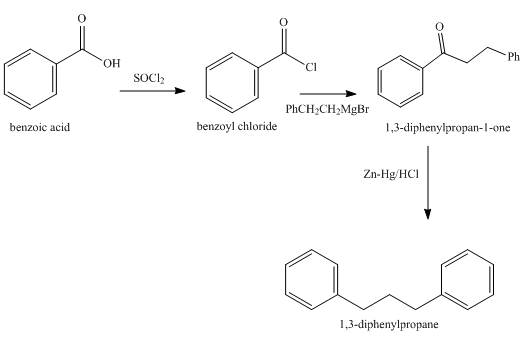
Explanation of Solution
The synthesis of

Figure 6
Benzoic acid is converted into benzoyl chloride in the first step which is then reacted with Grignard’s reagent to give an appropriate ketone which on Clemmensen reduction gives the required product
Synthesis of
(f)
Interpretation:
Synthesis of given
Concept introduction:
Synthesis is the process of conversion of one compound into another using reagents. For the conversion of one compound into another, the multiple numbers of steps undergo using multiple reagents.
Answer to Problem 20.47AP
Synthesis of given

Explanation of Solution
The synthesized compound is

Figure 7
Synthesis of given

Figure 8
The
Synthesis of given
(g)
Interpretation:
Synthesis of given dicarboxylic acid from norbornene using appropriate reagents is to be stated.
Concept introduction:
Synthesis is the process of conversion of one compound into another using reagents. For the conversion of one compound into another, the multiple numbers of steps undergo using multiple reagents.
Answer to Problem 20.47AP
Synthesis of given dicarboxylic acid from norbornene using appropriate reagents is shown below.

Explanation of Solution
The given dicarboxylic acid is shown below.
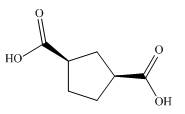
Figure 9
Synthesis of given dicarboxylic acid from norbornene using appropriate reagents is done in a single step shown below.

Figure 10
The conversion of norbornene into the required dicarboxylic acid is done in a single reaction. The ozonolysis of norbornene with oxidative work gives the required product.
Synthesis of given dicarboxylic acid from norbornene using appropriate reagents is shown in Figure 10.
(h)
Interpretation:
Synthesis of
Concept introduction:
Synthesis is the process of conversion of one compound into another using reagents. For the conversion of one compound into another, the multiple numbers of steps undergo using multiple reagents.
Answer to Problem 20.47AP
Synthesis of
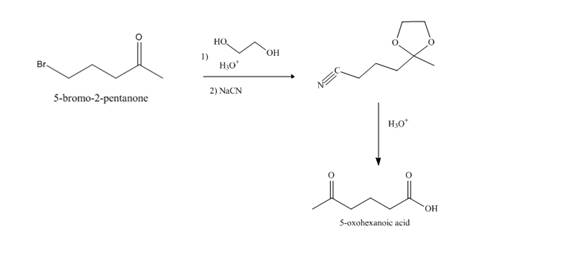
Explanation of Solution
Synthesis of

Figure 11
The compound,
Synthesis of
(i)
Interpretation:
Synthesis of
Concept introduction:
Synthesis is the process of conversion of one compound into another using reagents. For the conversion of one compound into another, the multiple numbers of steps undergo using multiple reagents.
Answer to Problem 20.47AP
Synthesis of
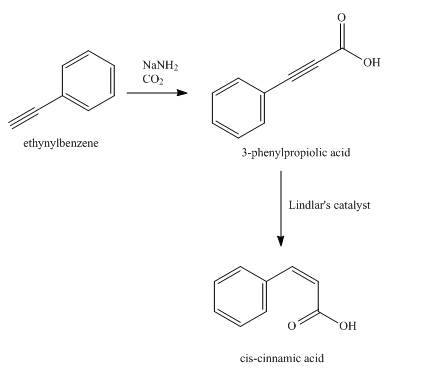
Explanation of Solution
Synthesis of

Figure 12
The compound,
Synthesis of
Want to see more full solutions like this?
Chapter 20 Solutions
Organic Chemistry
- Reaction A 0,0arrow_forwardpresented by Morillon Leaning Predict the organic product for the min кусур HSC Adithane carved arnown to come than that to the condon slchroruis in acid in in aquishri with ноюarrow_forward6.15PM Sun Mar 30 K Draw the major product of this reaction. Include any relevant stereochemistry. Ignore inorganic byproducts. Problem 1 of O H [PhзPCH2CH3]*C|¯ NaH Drawing > Q Atoms, Bonds and Draw or tap a nearrow_forward
- 8:17 PM Sun Mar 30 Draw the major product of this reaction. Ignore inorganic byproducts. HSCH2CH2CH2SH, BF3 Probler Drawing Ato Bonds Clarrow_forwardpresented by Mr L How the coprion. (Il Done in no wraction, dew the starting redential) доarrow_forward8:16 PM Sun Mar 30 K Draw the major product of this reaction. Ignore inorganic byproducts. Proble 1. CH3MgBr 2. H3O+ F Drawingarrow_forward
- о но оarrow_forwardName the major organic product of the following action of 4-chloro-4-methyl-1-pentanol in neutral pollution 10+ Now the product. The product has a molecular formula f b. In a singly hain, the starting, material again converts into a secule with the molecular kormula CIO. but with comply Draw the major organic structure inhalationarrow_forwardMacmillan Learning Alcohols can be oxidized by chromic acid derivatives. One such reagent is pyridinium chlorochromate, (C,H,NH*)(CICTO3), commonly known as PCC. Draw the proposed (neutral) intermediate and the organic product in the oxidation of 1-butanol by PCC when carried out in an anhydrous solvent such as CH₂C₁₂. PCC Intermediate OH CH2Cl2 Draw the intermediate. Select Draw Templates More с H Cr о Product Draw the product. Erase Select Draw Templates More H о Erasearrow_forward
- If I have 1-bromopropene, to obtain compound A, I have to add NaOH and another compound. Indicate which compound that would be. A C6H5 CH3arrow_forwardProvide the reagents for the following reactions.arrow_forwardIf I have 1-bromopropene, to obtain compound Z, I have to add two compounds A1 and A2. Indicate which compounds are needed. P(C6H5)3arrow_forward
